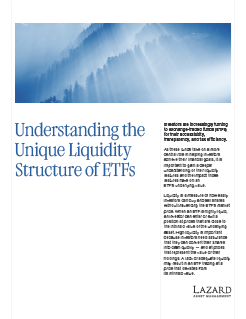ETF market depth refers to the number of shares available to buy or sell at the quoted price (top of the order book), as well as the additional shares available beyond the top-of-book levels. In simpler terms, it shows how much buying or selling an ETF can handle before its price starts to change. Deeper markets can accommodate larger orders without impacting the ETF’s price.
Investors are increasingly turning to exchange-traded funds (ETFs) for their accessibility, transparency, and tax efficiency.
As these funds take on a more central role in helping investors achieve their financial goals, it is important to gain a deeper understanding of their liquidity features and the impact those features have on an ETF’s underlying value.
Liquidity is a measure of how easily investors can buy and sell shares without influencing the ETF’s market price. When an ETF is highly liquid, an investor can enter or exit a position at prices that are close to the intrinsic value of the underlying asset. High liquidity is important because investors need assurance that they can convert their shares into cash quickly — and at prices that represent the value of their holdings. A lack of adequate liquidity may result in an ETF trading at a price that deviates from its intrinsic value.
The Difference Between ETF Liquidity and Stock Liquidity
One of the unique features of ETFs is their liquidity structure, which operates in two markets: the primary market and the secondary market. This dual-layer liquidity design is what differentiates ETFs from stocks.
Stocks, which trade only in secondary markets, have a fixed number of shares in circulation. As a result, a stock’s price fluctuates based on changes in its supply and demand. In this setting, average daily trading volume tends to indicate the stock’s liquidity.
ETFs, on the other hand, can experience below-average trading volumes or display low on-exchange trading activity without necessarily suffering from low liquidity. This is because ETFs are open-ended products, allowing the number of shares in circulation to adjust based on market demand. Built for scale, ETFs utilize a creation and redemption mechanism, which allows liquidity to originate directly from the underlying assets in the ETF’s portfolio.
The entities responsible for creating and redeeming the shares of an ETF are known as Authorized Participants (APs), sometimes referred to as Participating Dealers (PDs). These players act as a crucial link between the primary market, where ETF shares are initially created, and the secondary market, where investors trade those shares on exchanges, ensuring liquidity and alignment between the ETF’s market price and its underlying net asset value (NAV).
Measuring Liquidity
There are five metrics that can help assess ETF liquidity and better inform investment decisions in trade executions.
Trading volume represents the total number of ETF shares exchanged within a specific period. Elevated trading volume signals active participation from numerous investors buying and selling ETF shares.
The bid is the highest price a buyer is willing to pay for the ETF. The ask is the lowest price a seller is willing to accept for the ETF. Narrow bid-ask spreads signal higher liquidity and reduced costs for executing trades on behalf of clients. Conversely, wide bid-ask spreads can indicate lower liquidity and higher trading costs, which may impact the ease and efficiency of executing trades.
Basket spread measures the cost efficiency of trading an ETF’s underlying holdings through the creation and redemption process. The basket spread helps evaluate whether the ETF is cost-effective, particularly in volatile markets where transaction costs can fluctuate.
Basket liquidity assesses the tradability of the various securities held within the ETF. ETFs that hold highly liquid securities tend to offer narrower spreads and greater reliability.
How Liquidity Keeps ETF Prices in Line With Their Underlying Value
ETF liquidity plays an important role in ensuring that market prices accurately reflect the value of the underlying securities. Liquidity enables frequent buying and selling activity, allowing market participants to swiftly act on price discrepancies between the ETF and its underlying value. This facilitates efficient trading and helps maintain alignment between the ETF’s price on the secondary market.
Liquidity providers (LPs)—such as investment banks, broker-dealers, and market makers—serve as intermediaries by quoting both buy and sell prices for assets. Their role is crucial in keeping the buying and selling process active, which helps sustain liquidity.
Here’s how: LPs initially present bid and ask prices using the valuation of the underlying basket. From here, ETF arbitrage can take place. This process helps keep the ETF price from trading high above or far below the value of the underlying basket. As a result, the ETF has a suitable level of liquidity because it trades within a range that is very close to its value.
ETF arbitrage occurs when market participants respond to differences between the value of the underlying basket and the price of the ETF. When the ETF price is above the NAV, the APs can buy the underlying basket and deliver it to the ETF issuer. From here, the ETF issuer will create ETF shares, bringing the value and price discrepancy back into balance. APs can also do the reverse and buy the ETF when its price drops below the value of the underlying basket.
Three Key Benefits of Liquidity in ETFs and Why It Matters
1
The AP’s creation and redemption process allows shares to remain highly liquid regardless of asset size or trading volume. As a result, ETFs are usually able to meet investors’ liquidity needs even if the ETF has a relatively low average daily volume.
2
The mechanisms that underpin ETF liquidity ensure investors are more likely to trade shares at prices that closely align with the actual value of the underlying assets.
3
The two layers of the primary and secondary markets create a more flexible and scalable trading environment, compared to stocks.
Trading Best Practices
Discover Our Active ETFs
Important Information
Published: 30 October 2025.
Please consider a fund’s investment objectives, risks, charges, and expenses carefully before investing. For more complete information about Lazard ETFs and current performance, you may obtain a prospectus or summary prospectus by calling 800-823-6300 or going to www.lazardassetmanagement.com. Read the prospectus or summary prospectus carefully before you invest. The prospectus and summary prospectus contain investment objectives, risks, charges, expenses, and other information about the Portfolio and Lazard ETFs that may not be detailed in this document.
The Lazard ETFs are distributed by Foreside Fund Services, LLC.
Investment Products: NOT FDIC INSURED I NOT BANK GUARANTEED I MAY LOSE VALUE
Equity securities will fluctuate in price; the value of your investment will thus fluctuate, and this may result in a loss. Securities in certain non-domestic countries may be less liquid, more volatile, and less subject to governmental supervision than in one’s home market. The values of these securities may be affected by changes in currency rates, application of a country’s specific tax laws, changes in government administration, and economic and monetary policy. Emerging markets securities carry special risks, such as less developed or less efficient trading markets, a lack of company information, and differing auditing and legal standards. The securities markets of emerging markets countries can be extremely volatile; performance can also be influenced by political, social, and economic factors affecting companies in emerging markets countries.
Alpha is a measure of a stock’s performance relative to a benchmark index. A positive alpha indicates the stock has outperformed the market, while a negative alpha means it has underperformed.








